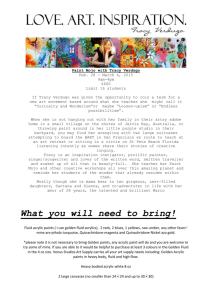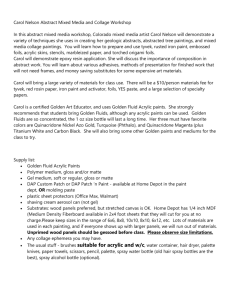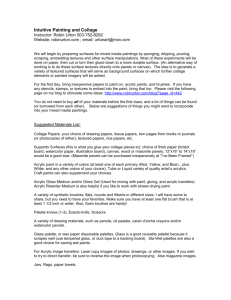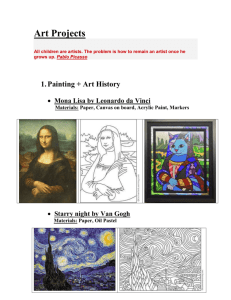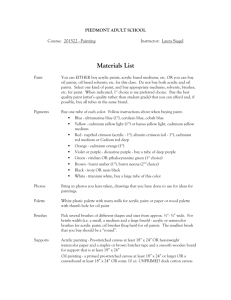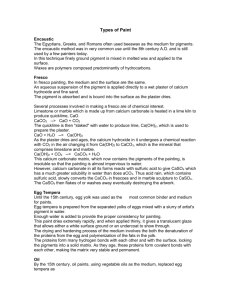e-PS, 2012, , 9-16 ISSN: 1581-9280 web edition e-PRESERVATIONScience
advertisement
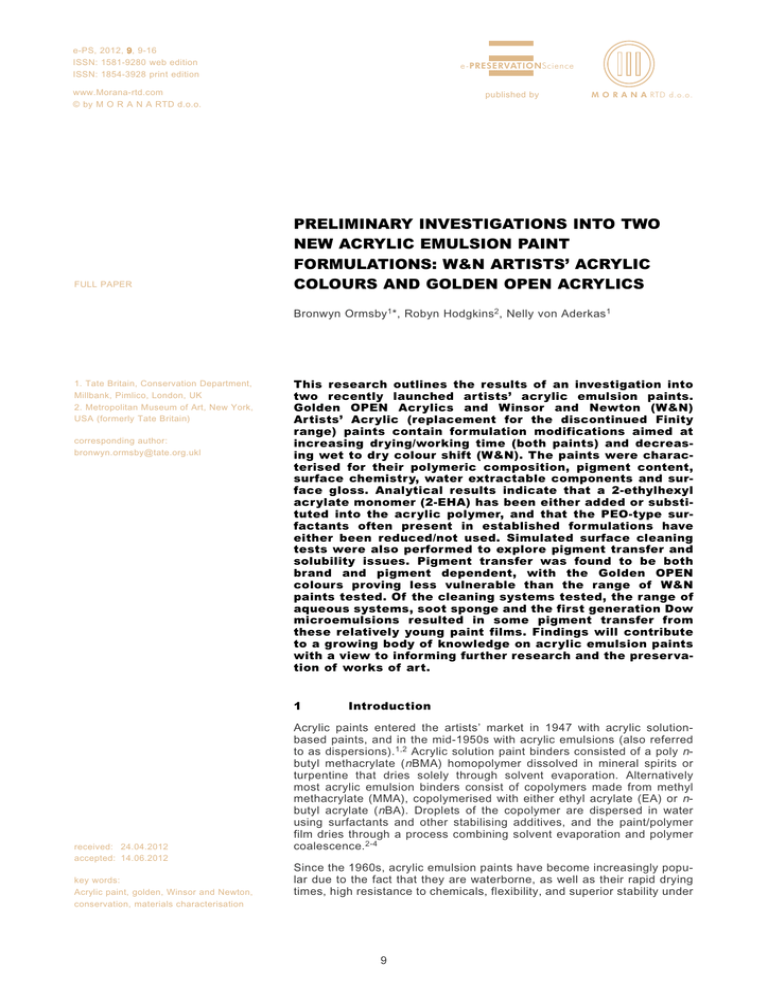
e-PS, 2012, 9, 9-16 ISSN: 1581-9280 web edition ISSN: 1854-3928 print edition e-PRESERVATIONScience www.Morana-rtd.com © by M O R A N A RTD d.o.o. FULL PAPER published by M O R A N A RTD d.o.o. PRELIMINARY INVESTIGATIONS INTO TWO NEW ACRYLIC EMULSION PAINT FORMULATIONS: W&N ARTISTS’ ACRYLIC COLOURS AND GOLDEN OPEN ACRYLICS Bronwyn Ormsby1*, Robyn Hodgkins2, Nelly von Aderkas1 1. Tate Britain, Conservation Department, Millbank, Pimlico, London, UK 2. Metropolitan Museum of Art, New York, USA (formerly Tate Britain) corresponding author: bronwyn.ormsby@tate.org.ukl This research outlines the results of an investigation into two recently launched artists’ acrylic emulsion paints. Golden OPEN Acrylics and Winsor and Newton (W&N) Artists’ Acrylic (replacement for the discontinued Finity range) paints contain formulation modifications aimed at increasing drying/working time (both paints) and decreasing wet to dry colour shift (W&N). The paints were characterised for their polymeric composition, pigment content, surface chemistry, water extractable components and surface gloss. Analytical results indicate that a 2-ethylhexyl acrylate monomer (2-EHA) has been either added or substituted into the acrylic polymer, and that the PEO-type surfactants often present in established formulations have either been reduced/not used. Simulated surface cleaning tests were also performed to explore pigment transfer and solubility issues. Pigment transfer was found to be both brand and pigment dependent, with the Golden OPEN colours proving less vulnerable than the range of W&N paints tested. Of the cleaning systems tested, the range of aqueous systems, soot sponge and the first generation Dow microemulsions resulted in some pigment transfer from these relatively young paint films. Findings will contribute to a growing body of knowledge on acrylic emulsion paints with a view to informing further research and the preservation of works of art. 1 received: 24.04.2012 accepted: 14.06.2012 key words: Acrylic paint, golden, Winsor and Newton, conservation, materials characterisation Introduction Acrylic paints entered the artists’ market in 1947 with acrylic solutionbased paints, and in the mid-1950s with acrylic emulsions (also referred to as dispersions).1,2 Acrylic solution paint binders consisted of a poly nbutyl methacrylate (nBMA) homopolymer dissolved in mineral spirits or turpentine that dries solely through solvent evaporation. Alternatively most acrylic emulsion binders consist of copolymers made from methyl methacrylate (MMA), copolymerised with either ethyl acrylate (EA) or nbutyl acrylate (nBA). Droplets of the copolymer are dispersed in water using surfactants and other stabilising additives, and the paint/polymer film dries through a process combining solvent evaporation and polymer coalescence.2-4 Since the 1960s, acrylic emulsion paints have become increasingly popular due to the fact that they are waterborne, as well as their rapid drying times, high resistance to chemicals, flexibility, and superior stability under 9 www.e-PRESERVATIONScience.org prolonged exposure to light.1,3-7 Today many brands of artists’ acrylic paint are available; each essentially consisting of polymeric (primarily) acrylic resin binders, pigments, extenders and a range of additives. These constituents vary over time due to formulation changes made by paint or raw materials manufacturers in response to legislative directives, changes in price and discontinued production of materials, as well as technical advances in core materials such as base emulsions.6 Two recently launched professional grade acrylic emulsion paints - Winsor & Newton’s (W&N) Artists’ Acrylic Colours (2009) and Golden OPEN Acrylic Colors (2008) - have been specifically formulated to address practical concerns with these paints, namely fast drying times and wet-to-dry colour shift. 2 Experimental 2.1 Paints Recommended starter sampler packs containing a limited range of paint colours were purchased for this study. The Winsor and Newton colours included: burnt sienna, cadmium orange, green gold, perylene violet, pyrrole red light, and yellow iron oxide. The Golden OPEN Acrylic colours included: alizarin crimson hue, hansa yellow opaque, Indian yellow hue, phthalocyanine blue (green shade), phthalocyanine green (blue shade), pyrrole red, quinacridone magenta, sap green, titanium white, ultramarine blue, and Van Dyke brown hue. Two similarly prepared samples of pnBA/MMA-based Liquitex Heavy Body Artists Acrylic colour – yellow light hansa (PY3) and cadmium orange (PO20) - were also evaluated as a comparison. The new range of Winsor & Newton Artists’ Acrylic colours replaces the discontinued Finity Artists Acrylic range, with the claim that these paints “are the brightest ever colour range of Artists’ Acrylics,” achieved largely by using a transparent binder that is “translucent when wet and dries clear.”8 This translucence is presumably due to advances in base acrylic polymer emulsion technologies, where transparency is afforded by a reduction in the average emulsion droplet size to the point (typically less than 100 nm) where visible light is no longer scattered. These paints also have working times that are said to be 20% longer than the discontinued Finity range (20 30 mins) and “dry to a water resistant film which is non-tacky.”8 This increased working time is presumably due to the incorporation of a humectant that retards drying by helping the paint retain water without compromising the film formation process. 2.2 Sample Preparation Films were cast onto glass slides and 10 ounce acrylic pre-primed cotton duck canvas sections (Russell and Chaple, London) using either a brush/palette knife or Sheen Instruments film caster. Samples were left to dry in a dark, dust free environment for up to one year prior to analysis. For the aqueous paint extracts, small paint samples were removed from the glass slides and placed in tubes with 100 μL of deionised water for a period of up to 16 days. The extracts were then pipetted onto clean cavity slides and dried in dark, dust free conditions. Scrapings of the extract material were taken from the cavity slide, placed onto a diamond transmission cell and analysed using infrared spectroscopy (see 2.4). Golden OPEN Acrylics are formulated to have relatively long working times as well as the novel ability to be reactivated several hours after initial application for reworking and blending purposes. Golden Artist Colors state that as long as the paint layers are relatively thin, after [a few days] the film then forms into a “characteristically strong and flexible acrylic emulsion film.”9 Golden does not discuss the humectants used in these paints, however they state that common choices such as ethylene glycol and diethylene glycol were not used because of a concern that humectants “cause hydroplasticisation, which is a further softening of the film as the result of water not being allowed to leave, or being absorbed back into the paint film.”10 Golden also states that the OPEN paints are intended to be used in layers less than 1/16th of an inch thickness and that works of art should be stored for a minimum of 30 days in a dust free environment before varnishing due to the slow drying and increased tack of these paints. 2.3 Surface Cleaning Tests A set of unsoiled painted samples on canvas (both new paint brands and the two Liquitex samples) were naturally aged for one year prior to testing. The cleaning materials were chosen from recent evaluations of cleaning systems for use on acrylic paint films.11 These consisted of five groups including: dry cleaning (soot sponge, Groomstick®); mineral spirits (Alcosol D40, Shellsol D38); aqueous (deionised water, 0.5% ECOSURF™ EH-9 in deionised water, 0.5% triammonium citrate (TAC) and 0.5% ECOSURF™ EH-9 in deionised water, 1% TAC in deionised water, 6 milliSiemens/cm (mS/cm) water at pH 6 (using citric acid and NaOH), 20 mS/cm water at pH 6 (using citric acid and NaOH); WIO (water-in-oil) microemulsions (a silicone microemulsion, a DOW experimental microemulsion largely based on mineral spirits), and saliva. Ideally, each significant new paint line should be investigated for properties that may have implications for the preservation and conservation of works of art and particularly when discontinued lines are replaced or claim to have novel properties. This study encompasses the investigation of sample paints from both brands for their polymer and pigment content, the preliminary identification of water-extractable compounds, surface chemistry, and important optical properties such as gloss. Tests were also carried out to assess pigment transfer and gloss changes during surface cleaning, in parallel with samples made from other acrylic paint formulations. Ready-made cotton swabs (Dynarex, USA) were dipped into each solution and rolled onto tissue prior to application to remove excess solvent. Each paint sample was “cleaned” with the group of 13 systems, until one of the following stages was reached: pigment was removed; visible damage was noted; or a maximum of 50 swab rolls had been applied. 11 The number of swab rolls (1 roll = one forward and back stroke) required to begin to remove pigment was noted, alongside any visible surface changes. Where pigment was removed, swab tests were repeated at Investigating New Artists’ Acrylic Paints, e-PS, 2012, 9, 9-16 10 © by M O R A N A RTD d.o.o. the same site to determine if the pigment transfer was due to the presence of unbound pigment on the paint film surface (in this case pigment would not continue to be removed with subsequent swabbing applications), or an indication of a more significant paint solubility issue. A cleaning system clearance step was not incorporated into this study as the main aim was to assess pigment transfer upon initial cleaning (rather than assessing soiling removal or cleaning efficacy). 3 Results and Discussion 3.1 Paint Characterisation (FTIR, EDX, PyGCMS) Dried samples of the paints were analyzed by μ-FTIR spectroscopy, PyGCMS and EDX analysis. Results are summarised in Tables 1 and 2. 3.1.1 2.4 Instrumentation 2.4.1 μ-FTIR Spectroscopy The pigment analysis results (Table 1) were in agreement with pigments listed on the paint tubes. No extender pigments were identified in any of the W&N paints, and only kaolinite was associated with ultramarine blue in the Golden paints analysed. This is not surprising as low levels of extender pigments are typical of high quality artists’ paints.12 Binder characterisation for the W&N paints suggested a possible 2ethyl hexyl acrylate/methyl methacrylate (2EHA/MMA) copolymer and the Golden OPEN paints binder appeared similar to a pnBA/MMA copolymer, however additional IR bands in the C-H stretching region (2931, 2860 cm-1) suggested the presence of another acrylic monomer (possibly 2-EHA), which was further investigated with PyGCMS (3.1.3). Micro-Fourier-Transform Infrared spectroscopy (μFTIR) analysis was carried out on a Thermo scientific Nicolet iN10 MX microscope using a diamond cell. 64 scans were collected at a resolution of 4 cm-1. All data was processed using Omnic8 software. 2.4.2 Attenuated Total Reflectance (FTIR-ATR) For ATR analysis, a germanium ATR crystal was used with a Nicolet iZ10 (Thermo Scientific) spectrometer for 64 scans at a resolution of 4 cm-1. At ~2000 cm-1 the system has a penetration depth of around 0.66 μm. All data was processed using Omnic8 software. 2.4.3 3.1.2 SEM-EDX 3.1.3 PyGCMS analysis PyGCMS PyGCMS results are listed in Tables 1, 3 and 4. Peaks common to all samples included methyl methacrylate (MMA) and 2-ethylhexyl acrylate (2EHA). The Winsor and Newton samples were confirmed as containing a p2-EHA/MMA copolymer binder, which is a different composition to the discontinued pnBA/MMA based Finity range. In addition to the MMA and 2-EHA monomers, the Golden paints also contain butyl acrylate ( n BA); “forming” p n BA/2EHA/MMA terpolymer (Table 3). In addition, the synthetic organic pigments PY73, PY74, PY129, PY150 and PR254 were identified (Table 4). Pyrolysis gas chromatography-mass spectrometry (PyGCMS) was carried out using a GSG Pyromat Curie point pyrolyser interfaced to a Varian Saturn 2000 GCMS. Pyrolysis conditions were 625 °C for 10 s. GC conditions: oven held at 40 °C for 2 mins then ramped to 320 °C at 10 °C/min, then held for further 2 mins at 320 °C. Column: Phenomenex Zebron ZB5MS column (30 m length; 0.25 mm i.d.; 0.25 µm film thickness). MS conditions: EI mode (70eV); scanned 40 - 399 amu every 0.49 s. 2.4.5 EDX analysis All paints were also analyzed by SEM-EDX (Table 2). The carbon and oxygen detected originates from the acrylic binding medium, and once again, the pigments listed on the paint tubes were confirmed as listed. In addition, traces of possible contaminants (Na, S), inorganic pigments (e.g. cadmium colours) and possible extenders (e.g. alumina, barium sulphate) were also identified. Scanning electron microscopy energy-dispersive xray spectroscopy (SEM-EDX) was carried out at the Natural History Museum, London using a LEO 1455VP SEM with INCA software at 20 KV and 100 Pa air pressure. 2.4.4 FTIR analysis Gloss Measurement 3.2 Gloss values were obtained using a Sheen Instruments Tri-Microgloss Meter 160 at a 60° angle. Measurements were taken of each sample in triplicate after 2 weeks, 4 months and 1 year of drying. Identification of Aqueous Extracted Materials (Transmission FTIR) Aqueous extracts of the paints were also analysed in an attempt to identify the extractable materials present. Despite the detection limitations inherent to infrared analysis, the groups of materials tentatively identified encompass: acrylic polymer, pigments, surfactants, protective colloids, dispersing agents, thickeners, and freeze/thaw stabilizers. The Golden OPEN paints appeared to contain materials similar to: Investigating New Artists’ Acrylic Paints, e-PS, 2012, 9, 9-16 11 www.e-PRESERVATIONScience.org Brand Pigment listed on tube No. Colour Winsor & Newton Artists’ Acrylic Pigment & Extender PyGCMS Medium Pigment 1 Green Gold PY129 PY129 PY129 2 Cadmium Orange PO20 - - 3 Burnt Sienna PR101 - 4 Pyrrole Red Light PR255 PR255 5 Perylene Violet PV29 PV29 - 6 Yellow Iron Oxide PY42 PY42/43 - 1 Sap Green Hue PY150, PBk7, PG36, PR101 PY150 PY150 2 Ultramarine Blue PB29 PB29, Kaolinite - Phthalo Green 3 (Blue Shade) PG7 PG7 - 4 Indian Yellow Hue PY73, PY150, PR206 PY73, PY150, PR206 PY73, PY150 PB15:4 PB15:4 Phthalo Blue, (Green Shade) VanDyke Brown 6 Hue 5 Golden OPEN Acrylics μ-FTIR Possibly 2-EHA/MMA p2-EHA/MMA - Probably pnBA/MMA (with possible 2-EHA) PBk7, PR101 - 7 Pyrrole Red PR254 - PR254 hansa Yellow 8 Opaque PY74 PY74 PY74 9 Titanium White PW6 PW6 - PR122 PR122 - PG7, PR122, PR206 PG7, PR122, PR206 - Quinacridone 10 Magenta Alizarin Crimson 11 Hue Medium - pnBA/2-EHA/MMA Table 1: Summary of Results for Paint Analysis: μ-FTIR, PYGCMS: W&N Artist Acrylic and Golden OPEN Acrylic paints. Brand W&N Paint colour Major elements detected Minor / trace Pigment listed elements detected on tube Green Gold C, O, K Cu, Na, Al, Si, P, S PY129 Cadmium Orange C, O, S, Cd Zn, Al, Se, Ba PO20 Burnt Sienna C, O, K, Fe, Ca Na, Si, P, S PR101 Pyrrole Red Light C,O, K Na, Si, S PR255 Perylene Violet C, O Na, Al, S, Ba PV29 Yellow Iron Oxide C, O, Ti, Fe Na, Al, Si, P, S PY42 Sap Green Hue C, O, Cl, Fe Ni, Al, Na, S, Br PY150, PBk7, PG36, PR101 Organic red pigment, possibly alumina and barium sulphate (no extenders detected in IR). Iron oxide confirmed, possibly bone black and titanium white (no bone black detected in IR). Nickel based pigment (probably PY150) and organic pigment with chlorine and bromine (possibly PG36). Ultramarine Blue C, O, K, Na, Al, Si, S Ca PB29 Ultramarine blue with kaolinite. Phthalo Green (Blue Shade) C, O, Cl Cu, Na, S PG7 Copper pigment with chlorine – likely to be phthalocyanine green. Na, Al, P, S, Ni PY73, PY150, PR206 Probably PY150 and other organic pigments with chlorine. C, O, Al Cu, Na, S PB15:4 Copper phthalocyanine pigment, (PB15), some alumina? C, O, Ca, Fe, Al Cu, Na, P, S PBk7, PR101 Iron oxide and alumina, possibly bone black. Pyrrole Red C, O, Cl Na, Al, S PR254 Organic pigment with chlorine. hansa Yellow Opaque C, O, Cl Na, S, Cu PY74 Organic pigment with chlorine. Titanium White C, O, Ti Na, Al, Si, S PW6 Titanium white, with pigment coating Quinacridone Magenta C, O Na, Al, P, S PR122 Organic pigment Alizarin Crimson C, O, Ca, Cl Na, Al, S PG7, PR122, PR206 Organic pigment with chlorine, some chalk/gypsum? Indian Yellow Hue C, O, Cl, N Golden Phthalo Blue (Green Shade) VanDyke Brown Hue SEM-EDX results - interpretation Copper complex pigment. Possibly with alumina or a pigment coating (no alumina detected in IR). Cadmium sulphide (some selenium) confirmed with possible extenders (no extenders detected in IR). Barium sulphate associated with Cd pigments. Iron oxide confirmed (possibly natural), with some extenders? Possibly bone black (no extenders/ bone black detected in IR). Organic red pigment. Table 2: Summary of SEM-EDX results: W&N Artist Acrylic and Golden OPEN Acrylic paints. Investigating New Artists’ Acrylic Paints, e-PS, 2012, 9, 9-16 12 © by M O R A N A RTD d.o.o. Brand W&N, Artists’ Acrylic Paint component Paint medium only Golden OPEN Paint Acrylics medium only Peak retention time (mins.) 4.7 5.7 8.4 9.6 12.8 13.8 4.6 5.7 7.4 9.6 12.7 13.8 Characteristic m/z valuesa Component ID 69, 55, 57, 57, 73, 69, 69, 55, 55, 57, 73, 70, MMAb 2-EHAb 2-EHA 2-EHA 2-EHA 2-EHA MMA 2-EHA nBAb 2-EHA 2-EHA 2-EHA 101, 41 70, 84, 41, 97, 112 72, 41, 43 71, 84, 41 71, 55, 41, 113 41, 55, 87, 112 101, 41 70, 41, 84, 97, 112 129, 41, 73, 103 41, 55, 70, 83 71, 55, 41, 113 41, 55, 71, 69, 83, 112, 157 Materials Identified 2-EHA/MMA copolymer nBA/2-EHA/ MMA terpolymer Table 3: Summary of PyGCMS paint medium results: W&N Artist Acrylic and Golden OPEN Acrylic paints. aion peaks reported in order of decreasing intensity (i.e. first ion listed is the base peak) 1n BA - butyl acrylate pyrolysis products; MMA - methyl methacrylate pyrolysis products; 2-EHA - 2-ethylhexyl acrylate pyrolysis products Organic General Brand and colour pigment Colour Chemical Index Number class W&N Green Gold PY129 Suggested structures (Source: Colour Index International) Methine/ Polymethine Retention Characteristic m/z values of salient peaks (ion of higtime (min) hest intensity: base peak listed first) 9.5 16.8 27.1 91, 119, 63 144, 115, 89, 63, 50 261, 260, 233, 63 Copper complex of Golden Indian Yellow Hue PY73 Monoazo 12.0 12.5 123, 124, 108, 80, 53 149, 106, 134, 120, 51, 78 Golden hansa Yellow Opaque PY74 Monoazo 12.0 12.5 17.8 123, 124, 108, 80, 53 149, 106, 134, 120, 51, 78 194, 164, 136, 92, 65 Monazo 9.0 11.5 281, 282 355, 356, 267, 73, 43 11.5 137, 102, 75, 50 Golden Sap PY150 Green Hue and Indian Yellow Hue Nickel complex of Golden Pyrrole Red PR254 Aminoketone Table 4: Summary of PyGCMS synthetic organic pigment results: W&N Artist Acrylic and Golden OPEN Acrylic paints. Investigating New Artists’ Acrylic Paints, e-PS, 2012, 9, 9-16 13 www.e-PRESERVATIONScience.org 40 Acrysol I-62 (a hydroxyl-functional pigment dispersant), Acrysol G-110 (an ammonium polyacrylate dispersing agent and thickener), Tamol 1124 (an ammonium copolymer electrolyte dispersing agent and thickener), Nopcosperse 44 (a sodium carboxylate polyelectrolyte) in addition to pigments extracted from the Alizarin Crimson Hue, Phthalocyanine blue and Phthalocyanine green samples. It is important to note that a more sensitive technique, such as liquid chromatography - mass spectrometry (LCMS) would offer more certain identification of the extracted materials.13 The Winsor and Newton paint extracts also contained similar materials with the addition of possible: Natrasol 250 LR (a hydroxyethylcellulose based protective colloid and paint thickener) and Aerosol 22 (tetrasodium N-(1, 2-dicarboxyethyl)-N-octadecyl sulfosuccinamate)/Aerosol OT-75 (sodium dioctyl sulfosuccinate) which are both wetting and dispersing agents. The Perylene Violet sample alone, also contained amounts of a poly ethoxylate-based (PEO) material similar to the Triton X surfactants identified in earlier formulations.3,13,14 0.5 4 12 35 months months months 30 Gloss (at 60 deg) 25 20 15 10 5 0 Burnt Siena Cadmium Orange Green Gold W&N Pyrrole Red Light Perylene Violet Yellow Iron Oxide Figure 1: Winsor & Newton Artists’ Acrylics: gloss readings (60 o angle) at drying times of 2 weeks, 4 months and 12 months. 16 0.5 4 12 14 months months months 12 3.4 6 4 Hansa Yellow Opaque VanDyke Brown Hue Ultramarine Blue Titanium White Sap Green Hue Quinacridone Magenta Pyrole Red Phthalo Green (Blue) Phthalo Blue (Green) 2 0 Golden Surface Gloss Figure 2: Golden OPEN Acrylics: gloss readings (60 ing times of 2 weeks, 4 months and 12 months. During the paint drying process, surface gloss can change considerably.3 To track this, measurements were taken after 2 weeks, 4 months and 1 year of drying for both canvas sample sets. Golden Artist Colors state that the OPEN paints are quite glossy after painting out, and that as the water-based humectant evaporates the surface gloss changes, becoming more even.10 The data in Figures 1 and 2 reveals that at the 2 week point, the W&N paints were more glossy than the OPEN colours, which then slightly increased in (average) gloss over the one year (with the exception of the Perylene Violet sample). The Golden OPEN paints were more matte and tended to lose gloss between 2 weeks and 4 months. This is presumably due to the evaporation of the humectant, with little further gloss change occurring between 4 months and one year. 3.5 8 Indian Yellow Hue It is now well established that polyethoxylate-type (PEO) surfactants migrate to the surface of acrylic emulsion paint films.3, 14-16 Each sample was therefore assessed with ATR analysis for evidence of migrated material after 2 weeks, 4 months and 1 year of ambient drying. Results revealed that only the W&N Perylene Violet sample had detectable amounts of migrated PEO surfactant; which was also identified in the corresponding aqueous extract (see 3.2). 10 Alizarin Crimson Hue Surface Chemistry (FTIR-ATR) Gloss (at 60 deg) 3.3 o angle) at dry- vent-soluble materials present (i.e. formulation), the acrylic polymer composition, and the artists’ technique. To explore this issue, the thirteen cleaning methods (see 2.3) were applied to the W&N and Golden samples and compared to the two equivalent Liquitex paint samples (known to be relatively highly swelling when compared to other “older” formulations).17 After one year of drying, pigment transfer was noted earlier (i.e. lower numbers of swab rolls/fewer applications) for the W&N paints than the Golden OPEN colours. This trend is visible in Figure 3, where the number of swab rolls required to cause pigment transfer on representative samples chosen from each brand have been presented. It is expected that the paints would become more robust with time, however the differences noted between the different cleaning system types is also of interest. Surface Cleaning and Pigment Transfer When approaching the conservation treatment of acrylic paint films, one of the risks that conservators are naturally cautious about is pigment transfer during cleaning. This has been explored to some extent in recent research.11,15 Pigment transfer onto swabs or other cleaning materials can be experienced as a one-off occurrence, where presumably unbound pigment is removed from the surface. However, where repeated swabbing results in further pigment transfer, this can indicate the presence of a paint solubility issue, which may be related to the age of the paint, the amounts of surfactant and other sol- As can be seen in Figure 3, the W&N sample proved more susceptible to pigment transfer with saliva, the group of aqueous solutions, and the DOW microemulsion than the Golden OPEN sample. In these cases, all systems also caused a visible decrease in gloss. On occasions, soot sponge also resulted in slight pigment transfer and changes in gloss. Pigment transfer was generally rare for the OPEN colours except for when the soot sponge and DOW microemulsions were used (see Figure 3). The surface gloss of the Golden OPEN samples tended to be less Investigating New Artists’ Acrylic Paints, e-PS, 2012, 9, 9-16 14 Winsor & Newton, Burn Sienna 50 40 30 Golden, Phthaloczanine Blue © by M O R A N A RTD d.o.o. 20 Dry Mineral Spirit Aqueous Microemulsion Saliva DOW Microemulsion (ME9) Wolbers Microemulsion (ME5) 20 mS/cm Water at pH 6 6 mS/cm Water at pH 6 1% Triammonium Citrate 0.5% TAC 0.5% Ecosurf EH-9 0.5% Ecosurf EK-9 Deionised Water Shellsol D38 Alcosol D40 Stoot Sponge 0 Groom Stick 10 Saliva Figure 3: Number of swab rolls/applications required until pigment was removed using 13 cleaning methods on W&N Artists’ Acrylics and Golden OPEN Acrylics. robust however; for these samples the aqueous and mineral spirits systems affected gloss without necessarily removing pigment. In all cases (except the Liquitex PY3 sample), the DOW water-in-oil microemulsions removed some pigment beyond the initial pigment transfer process and caused decreases in surface gloss. While these systems are proving highly effective at soiling removal,11 (acrylic) paint solubility is currently being addressed through modifications to the microemulsion formulations. relatively free of extenders, which is typical of professional grade artists’ paints, and the aqueous extractable additives appeared to be similar to those identified in older paints. One important exception is the general absence of non-ionic polyethoxylate type surfactants such as Triton®X-405, either on the surface or in the aqueous extracts of these paints (with one exception); which may have implications for conservation treatment and display. Additionally, the relative initial softness and slower drying rate of the Golden OPEN Acrylics may have implications for soiling and surface cleaning treatment. At 2 weeks drying time, the W&N paints proved glossier than the Golden OPEN range, and small changes in gloss were noted for both paints across the one-year assessment period. Pigment transfer also varied to some extent with pigment type within the one brand. For the Golden OPEN range, the Van Dyke brown hue and Indian yellow hue samples proved more susceptible to pigment transfer. The W&N samples were more varied, with the pyrrole red light and cadmium orange paints proving relatively resistant to pigment transfer and the perylene violet, green gold and burnt sienna paints proving more susceptible. The two “older” Liquitex samples (with some surface surfactant present) also exhibited a varied response: the cadmium orange (PO20) sample responded similarly to the group of susceptible W&N colours and the azo yellow (PY3) sample responded similarly to the more robust Golden OPEN colours. This suggests that the new formulations behave similarly with respect to pigment transfer and solubility to the older formulations; and that this is an area that requires further investigation. 4 Understanding the issue of pigment transfer during surface cleaning is complex and at least depends on the age of the paint film, the amounts of solvent-soluble materials present, pigment type (i.e. formulation), film forming conditions, the cleaning systems used, the cleaning application method and exposure time, as well as artists’ technique. The general susceptibility to pigment transfer of these new paints appeared similar to the older pnBA/MMA Liquitex formulation also evaluated. Regarding the effects of cleaning systems tested, the W&N samples appeared less affected by the mineral spirits-based and dry cleaning systems, however the range of aqueous and microemulsion systems resulted in varying degrees of pigment transfer. After an initial coloured swab, the aqueous cleaning treatments did not remove significantly more pigment, which suggests loose pigment was being removed, with accompanying changes in gloss. The Golden OPEN colours proved less vulnerable to pigment transfer than the W&N paints however they appeared to be particularly susceptible to gloss changes. The DOW microemulsion system repeatedly removed some colour from almost all samples, indicating the presence of a potential solubility issue that is current- Conclusions This preliminary study has established that these two recently launched acrylic paint formulations have slightly different copolymer compositions (i.e. base emulsions) than the pEA/MMA and pnBA/MMA formulations typically used in other artists’ acrylic paints. For the Winsor & Newton Artists’ Acrylic colours, the traditional pnBA has been replaced with a p2-EHA monomer, resulting in a p2-EHA/MMA acrylic copolymer. For the Golden OPEN Acrylic colours, p2-EHA has been added to the acrylic resin, creating a pnBA/2-EHA/MMA terpolymer. Both paints remain Investigating New Artists’ Acrylic Paints, e-PS, 2012, 9, 9-16 15 www.e-PRESERVATIONScience.org 12. T. Learner, The use of FT-IR in the conservation of twentieth century paintings, Spectrosc. Eur. 1996, 8, 14-19. ly being addressed by the microemulsion manufacturer. In some cases the soot sponge also proved problematic with respect to pigment loss and gloss changes. 13. G.D. Smith, A “single-shot’ separation and identification technique for water extractable additives in acrylic emulsion paints, 14th Triennial Meeting International Council of Museums – Committee for Conservation, The Hague. Verger (Ed.), James & James/Earthscan, London, Volume 1, 2005, 824-832. Further ageing is clearly necessary to provide information on the likely medium to long-term properties of these new paint formulations. Additional studies exploring the removal of soiling layers and approximating conservation cleaning practice more closely through incorporating clearance steps etc. would increase our understanding of the potential risks associated with the conservation and preservation of works of art made with acrylic paints. 5 14. B. Ormsby, E. Kampasakli, C. Miliani, T. Learner, An FTIRbased exploration of the effects of wet cleaning treatments on artists’ acrylic emulsion paint films, e-Preserv. Sci., 2009, 6, 186195. 15. B. Ormsby, P. Smithen, F. Hoogland, C. Miliani, T. Learner, A scientific evaluation of surface cleaning acrylic emulsion paintings , 15th Triennial Meeting International Council of Museums – Committee for Conservation, New Delhi, Allied Publishers, New Delhi, 2008, 857-886. Acknowledgements B. Ormsby would like to thank Dr. Joyce Townsend, Senior Conservation Scientist at Tate, London; former Tate intern Verena Franken and Dr. Melinda Keefe of The Dow Chemical Company, Spring House, Pennsylvania. R. Hodgkins would like to thank the NSF IGERT Materials Creation Training Program (MCTP) (DGE-0654431) and the California NanoSystems Institute and BUNAC UK, London for traineeship support. N. von Aderkas would like to thank the Skills for the Future Heritage Lottery Fund traineeship programme. 6 16. D. Scalarone, O. Chiantore, FTIR monitoring of surfactant phase-separation and stability in waterborne organic coatings and artists’ acrylic paints, Proceedings of the Sixth Infrared and Raman Users Group Conference (IRUG 6), Florence, Italy, ed. M. Picollo, Il Prato, Padova, 2005, 52–57. 17. E. Kampasakali, B. Ormsby, A. Phenix, M. Schilling, T. Learner, A preliminary study into the swelling behaviour of artists’ acrylic emulsion paint films, International Council of Museums – Committee for Conservation, Lisbon, Portugal, September, 2011. References 1. T. Learner, Analysis of Modern Paints, The Getty Conservation Institute, Los Angeles, 2004, pp. 43, 49, 54, 68, 184. 2. E. Jablonski, T. Learner, J. Hayes, M. Golden, Conservation concerns for acrylic emulsion paints, Rev. Conserv., 2003, 4, 3-12. 3. B. Ormsby, T. Learner, The effects of wet surface cleaning treatments on acrylic emulsion artists’ paints- a review of recent scientific research, Rev. Conserv., 2009, 10, 29-41. 4. T. Learner, Modern Paints, Sackler NAS Colloquium: Scientific Examination of Art: Modern Techniques in Conservation and Analysis, 2005, 137-151. 5. T. Learner, O. Chiantore, D. Scalarone, Ageing studies of acrylic emulsion paints, ICOM Committee for Conservation, 13th Triennial Meeting, Rio de Janeiro, Preprints, ed. R. Vontobel, James & James, London, Vol. II, 2002, 911-919. 6. S. Croll, Overview of developments in the paint industry since 1930, Modern Paints Uncovered, proceedings from the Modern Paints Uncovered Symposium, May 16–19, 2006, Tate Modern, London, T.J.S. Learner, P. Smithen, J.W. Krueger, M.R. Schilling, Eds., Getty Conservation Institute, Los Angeles, 2007, 17-29. 7. D. Scalarone, O. Chiantore, Separation techniques for the analysis of artists’ acrylic emulsion paints, J. Separ. Sci. 2004, 27, 263-274. 8. www.winsornewton.com/products/acrylic-colours/artists-acryliccolour-/ (accessed 01/03/2011). 9. www.goldenpaints.com/technicaldata/open.php (accessed 01/03/2011). 10. http://www.goldenpaints.com/justpaint/JP19.pdf (accessed 01/03/2011). 11. M. Keefe, B. Ormsby, A. Soldano, A. Phenix, T. Learner, C. Tucker, A. Behr, G. Meyers, C. Rheinhardt, T. Boomgaard, C. Peitsch, Art and industry: novel approaches to the evaluation and development of cleaning systems for artists’ acrylic latex paints, Coatings Tech, American Coatings Association, September 2011, 26-39. Investigating New Artists’ Acrylic Paints, e-PS, 2012, 9, 9-16 16
